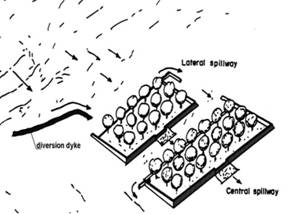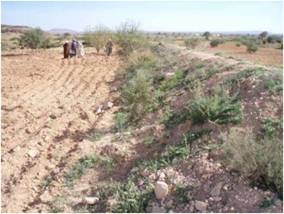Tabia
The tabia technique is similar to the jessour system used in the foothill and piedmont areas. It is considered to be a relatively new technique, developed by mountain dwellers who migrated to the plains. Alaya et al. (1993) have reported that the ancient remnants of tabias have been found in the region of Gafsa. The system has been adopted by people living in the neighboring foothills and plains of the central and southeastern regions (Jeffara) of the country, following the transformation of their pasture to cultivated fields (Figures 7, 5) (Photo 2).
The tabia runoff water harvesting technique is widely practiced in central Tunisia. Tabias are usually installed on the piedmont, where the slope does not exceed 3% and where the soil is relatively deep. Tabias, like jessour, are comprised of a dyke (50-150 m in length, 1-1.5 m in height), a spillway (central and/or lateral) and an impluvium. Impluvium/cropped area ratios vary from 6 to 20. The differences between the tabia and the jessour systems are that the former contains two additional lateral bunds (up to 30 m long) and sometimes a small flood diversion dyke (mgoud) (Alaya et al., 1993). Fruit trees and annual crops are commonly grown using tabia. Besides their water harvesting qualities, tabias also have a positive effect on soil erosion and groundwater recharge.
|
Figure 7: Scheme of tabias with natural impluvium (adapted from Alaya et al., 1993). |
Photo 2: Tabias in the piemond area of Bhaira |

